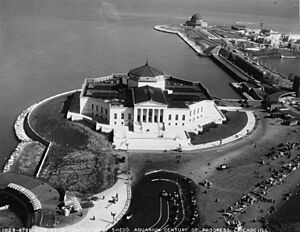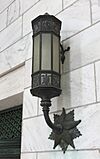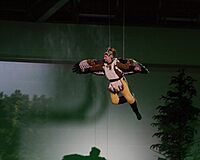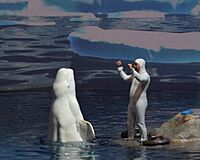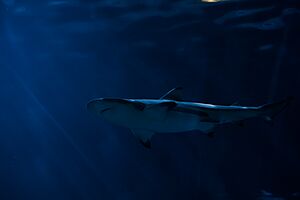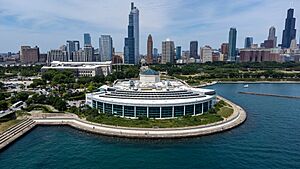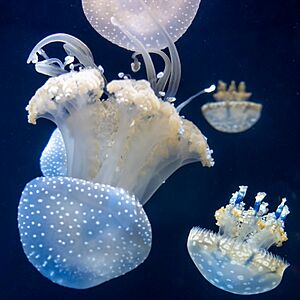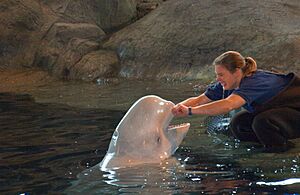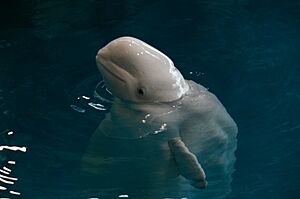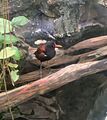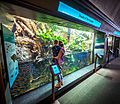Shedd Aquarium facts for kids
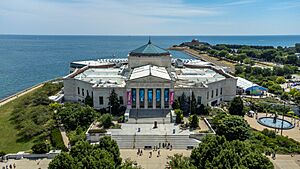
The Aquarium in 2022
|
|
| Date opened | May 30, 1930 |
|---|---|
| Location | 1200 South Lake Shore Drive Chicago, Illinois, United States |
| No. of animals | 32,000 |
| No. of species | 1,500 |
| Total volume of tanks | 5 million US gallons (19,000 m3) |
| Annual visitors | 2.02 million |
| Memberships | AZA, WAZA |
| Major exhibits | Amazon Rising, Caribbean Reef, Abbott Oceanarium, Polar Play Zone, Waters of the World, Wild Reef |
The Shedd Aquarium is a huge indoor aquarium in Chicago, Illinois. It opened on May 30, 1930. This amazing place holds about 32,000 animals in its tanks, which can hold 5 million gallons of water!
It is one of the largest aquariums in the world. The Shedd Aquarium was the first inland aquarium to have a permanent collection of saltwater fish. It sits right by Lake Michigan in Chicago's Museum Campus. This area also has other cool places like the Adler Planetarium and the Field Museum of Natural History.
In 2015, over 2 million people visited the Shedd Aquarium. It was the most visited aquarium in the Western Hemisphere in 2005. By 2007, it became the most popular cultural spot in Chicago. The aquarium is home to 1,500 different kinds of animals. These include fish, marine mammals, birds, snakes, amphibians, and even insects!
The Shedd Aquarium has won awards for its exhibits. These include "Seahorse Symphony" (1999), "Amazon Rising" (2001), and "Wild Reef" (2004). It was also named a National Historic Landmark in 1987.
Contents
History of the Shedd Aquarium
The Shedd Aquarium was a gift to Chicago from John G. Shedd. He was a famous retail leader. John G. Shedd passed away before the aquarium was finished. But his wife, Mary R. Shedd, opened it officially.
The aquarium cost $3 million to build. Construction started on November 2, 1927. It was finished on December 19, 1929. The first exhibits opened on May 30, 1930. Since it was one of the first inland aquariums, getting seawater was a challenge. A special train car, called the Nautilus, brought fish and seawater from far away. This train car was used until 1959.
In 1930, 20 train cars made eight trips. They traveled between Key West and Chicago. This brought 1 million gallons of seawater for the aquarium's exhibits. In 1933, Chicago hosted a big event called the Century of Progress world's fair. The aquarium was right next to the fairgrounds. This helped many people from all over the world discover the Shedd.
In 1971, the Shedd Aquarium added a popular exhibit. It was a 90,000-gallon tank showing a Caribbean coral reef. That same year, the aquarium got its first research boat. This 75-foot boat explored the Caribbean. It helped scientists study and collect animals. In 1985, a new boat, the Coral Reef II, replaced it. In 1987, the Shedd Aquarium became a National Historic Place.
Aquarium Architecture and Design
The Shedd Aquarium is famous for its beautiful architecture. The design was created by Graham, Anderson, Probst & White. It looks like classical Greek buildings. This style, called Beaux Arts, matches other buildings in the Museum Campus.
The main aquarium building has eight sides. It has Doric columns and a grand staircase. A dome sits on top. You can see sea-themed designs everywhere. Tortoise shells, dolphins, octopuses, waves, and even Poseidon's trident are carved into the building.
The Oceanarium part of the aquarium is more modern. It looks like the Pacific Northwest. But it still fits well with the older building. "Whale Harbor," the Oceanarium's main tank, holds 2 million gallons. It has a wall of windows that look out onto Lake Michigan.
Amazing Exhibits and Shows
The Shedd Aquarium has many permanent exhibits. These include Waters of the World, Wonder of Water, Amazon Rising, Wild Reef, and the Abbott Oceanarium.
Waters of the World Exhibit
These are the oldest galleries in the aquarium. They show animals from oceans, rivers, islands, and lakes. You can also see creatures from Chicago's local waters. Some animals here are American bullfrogs, a giant Pacific octopus, American alligators, lake sturgeon, starfish, lined seahorses, and alligator snapping turtles.
Wonder of Water Exhibit
The original Caribbean Reef exhibit was built in 1971. It replaced the aquarium's first exhibit, the Tropical Pool. A cool part of this exhibit is a diver. The diver interacts with the animals and talks to visitors. The exhibit has a 90,000-gallon round tank. This tank lets you see the animals from all sides. It was one of the first places to show fish swimming in schools.
This exhibit is also home to Nickel, a rescued green sea turtle. You can also see Atlantic tarpons, cownose rays, redband parrotfish, Bonnethead sharks, and a Green moray eel. The exhibit is near the center of the first floor. It is close to Amazon Rising, Waters of the World, and Wild Reef. The Caribbean Reef tank closed in 2023. It will be replaced by a tunnel connecting two main parts of the aquarium. Two new tanks will also replace the original Caribbean Reef tank. Wonder of Water opened in December 2024.
Amazon Rising Exhibit
The Amazon Rising exhibit is an 8,600-square-foot walkthrough. It recreates a flooded forest from the Amazon River and its jungle. This exhibit has 250 different species. The water can be up to 6 feet deep.
Animals from this area include a green anaconda, red-bellied piranhas, electric eels, freshwater stingrays, dwarf caimans, caiman lizards, wattled jacanas, yellow-spotted river turtles, red-footed tortoises, yellow-footed tortoises, mata matas, Arapaimas, and many kinds of South American birds, fish, and frogs.
Wild Reef Exhibit
In 2003, Shedd opened Wild Reef. This permanent exhibit is two levels below the main building. It holds 525,000 gallons of water. It looks like a Philippine coral reef from the Apo Island marine reserve. You can see living coral, many kinds of fish and rays. There is also a collection of sharks. These include sandbar, zebra, blacktip reef sharks, white-spotted guitarfish, Spotted wobbegongs, and Japanese wobbegongs.
The main attraction is a 400,000-gallon shark tank. It has 12-foot-high curved windows. This gives visitors a diver's view of the sharks. The Wild Reef exhibit also has a saltwater tank. Here, coral is grown for conservation efforts.
Oceanarium Exhibit
In 1991, Shedd Aquarium opened the Oceanarium. It is now called the Abbott Oceanarium. This large addition features marine mammals. You can see Pacific white-sided dolphins, beluga whales, sea otters, and California sea lions. Next to the sea lion exhibit is an open tank for cuttlefish. Near the sea otter exhibit, there is a large touch tank. Here, you can touch tide pool creatures like crabs, sea cucumbers, and sea anemones.
The lower level of the Oceanarium lets you see the beluga whales and dolphins underwater. The Oceanarium holds 3 million gallons of water in total. The biggest tank, "Whale Harbour," holds 2 million gallons.
The Oceanarium is the largest indoor marine mammal facility in the world. It also has a 1,000-seat theater. Here, you can watch an educational marine mammal show. Some of the sea otters that lived here were rescued. They were saved from the Exxon Valdez oil spill in 1989. In 2008, the Oceanarium closed for repairs. The animals moved to other zoos temporarily. It reopened in May 2009.
Polar Play Zone Exhibit
This exhibit is an interactive play area for kids. It has an underwater viewing area. You can see beluga whales, Pacific white-sided dolphins, and sea otters. The exhibit also features Southern rockhopper penguins and magellanic penguins. There are five round tanks for moon jellyfish and starfishes. These are next to an interactive submarine model. There is also a starfish touch pool.
Stingray Touch Exhibit
This exhibit is on the aquarium's South Terrace. Guests can touch cownose rays as they swim. The rays are in a 20,000-gallon outdoor exhibit. It is open during the warmer months, from May to October.
Plankton Revealed Exhibit
The Plankton Revealed exhibit opened in July 2023. It teaches visitors about the importance of plankton. It features flamboyant cuttlefish, white-spotted jellyfish, brine shrimp, and other tiny animals. This interactive exhibit is the first at the aquarium to be fully bilingual. It includes Spanish translations.
4D Theater Experience
The 4D Theater opened in 2009. It was part of the Abbott Oceanarium's renovation. The 4D experience includes a 3D film. It has interactive seats, great sound, and special effects. You might feel scents or bubbles! Past films have included SpongeBob SquarePants 4-D and The Polar Express.
Past Special Exhibits
Jellies Exhibit
The "Jellies" exhibit opened in April 2011. It focused on jellyfish and common misunderstandings about them. It showed at least 10 types of jellyfish. These included moon jellyfish, egg-yolk jellyfish, and purple-striped jelly. This exhibit closed in 2015.
Underwater Beauty Exhibit
This exhibit opened on May 25, 2018. It showed the visual beauty of sea life. It had sections called "Color," "Patterns," and "Rhythms." The exhibit featured 100 different kinds of fish and invertebrates. They were displayed to highlight their amazing looks. This exhibit closed on April 17, 2023.
Amphibians Exhibit
The amphibian exhibit ran from May 15, 2015, to January 1, 2018. It featured 40 different kinds of amphibians. These included the gray tree frog, poison dart frog, fire-bellied toad, and axolotl.
Seahorse Symphony Exhibit
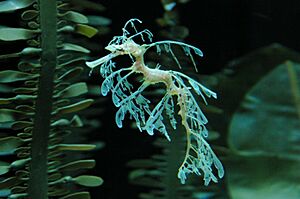
The Seahorse Symphony exhibit was open from 1998 to 2003. It featured many interesting species. These included trumpetfish, snipefish, shrimpfish, leafy seadragon, and weedy seadragon.
Animals at the Shedd Aquarium
The Shedd Aquarium is home to many amazing animals. Some have become very famous!
Granddad the Australian Lungfish
Granddad, an Australian lungfish, arrived at the Shedd in 1933. He came from Sydney during the Century of Progress world fair. He and his mate attracted about 4.5 million visitors.
When Granddad passed away in 2017, he was believed to be the oldest fish in any aquarium. He was 109 years old! He weighed 25 pounds and was 4 feet long. Granddad usually rested like a sunken log at the bottom of his habitat.
Beluga Whales at Shedd
As of November 15, 2022, the Shedd Aquarium has eight living Beluga whales. Their names are Naya (female), Beethoven (male), Kayavak (female), Bella (female), Aurek (male), Kimalu (female), Annik (male), and Atlas (male).
- Mauyak gave birth to Qannik in 2000. Qannik later moved to Point Defiance Zoo. In 2007, Mauyak gave birth to a male calf named Miki. Miki moved to the Mystic Aquarium in 2016. In 2012, Mauyak had a female calf named Kimalu. On July 3, 2019, Mauyak gave birth to a male calf, Annik. Mauyak passed away on November 12, 2022.
- Kayavak is a very famous whale at the Oceanarium. She became an orphan when she was only five months old. Her mother, Immiayuk, died. Trainers worked hard to feed and care for Kayavak. They taught her how to "be a whale," and she grew into a healthy adult.
- Puiji gave birth to a female calf named Bella in 2006. In 2009, she had a male calf named Nunavik. Nunavik means "friendly, beautiful, and wild." Nunavik now lives at the Georgia Aquarium. Puiji passed away in 2011 after a seizure.
- Naluark moved to Mystic Aquarium in 2011. He later moved to SeaWorld Orlando in 2016.
- Naya arrived at Shedd Aquarium in 1992. She has had four calves. In 2009, she gave birth to a male calf, but he passed away two days later. In 2020, Naya had premature twins. The first calf survived birth but had health issues and passed away 15 days later.
Alaskan Sea Otters
- Yaku, son of Kenai, was humanely euthanized on February 26, 2022. He had a tumor in his chest.
- Kenai, who survived the Exxon Valdez oil spill, was humanely euthanized on October 9, 2012. He was very old and had failing health.
- Kachemak, the oldest sea otter in a North American aquarium, was humanely euthanized on August 24, 2013. This was due to age-related health issues.
- Seldovia (male) arrived at the Shedd Aquarium on November 29, 2023. He is currently the only Alaskan sea otter at Shedd. He shares his home with the Southern sea otters.
Southern Sea Otters
The Shedd Aquarium is home to several Southern sea otters: Luna (female), Cooper (male), Watson (male), Suri (female), and Willow (female).
Pacific White-Sided Dolphins
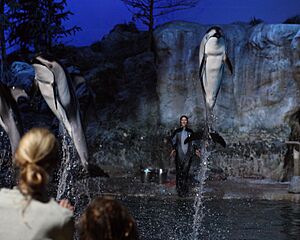
The aquarium has seven white-sided dolphins: Loke (female), Kri (female), Katrl (female), Munchkin (female), Makoa (male), Elelo (male), and Harmony (female).
- Males Sagu and Makoa were born to Piquet. Piquet gave birth to Sagu in 2012 and Makoa in 2015. Piquet moved to Miami Seaquarium for a breeding loan in 2018. Ipo was transferred to Shedd. Piquet returned in 2019. Ipo and Piquet moved to SeaWorld San Antonio in 2020. Sagu passed away in May 2021.
- Kri has lived at the Shedd Aquarium on and off since 1991. She moved to the Mystic Aquarium in 2009 and the Miami Seaquarium in 2013.
- Katrl arrived at Shedd Aquarium in 1993. On April 18, 2016, Katrl gave birth to a male calf named Kukdlaa, meaning "Bubbles." Kukdlaa passed away in 2019. Harmony was born to Katrl and Sagu on August 31, 2020.
- Loke and her son Elelo arrived at Shedd Aquarium on August 3, 2023. They had been living off-display at the Miami Seaquarium. This move happened because of concerns about the Miami Seaquarium's facilities.
Nickel the Green Sea Turtle
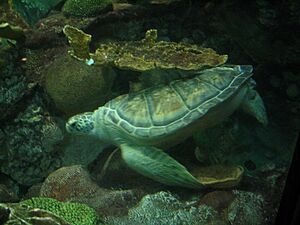
Nickel is a female green sea turtle who lives in the Caribbean Reef exhibit. She was rescued in Florida in 1998. A motorboat hit her, damaging her shell and paralyzing her lower body. This caused her to have trouble floating.
Researchers thought she could not live in the wild. So, she came to Shedd in 2003. During an X-ray, they found a 1975 nickel coin in her throat! That's how she got her name. Nickel is one of many rescued animals at Shedd. She helps teach people about how human actions can affect wildlife.
Rio the North American River Otter
Rio was humanely euthanized on October 29, 2013. He was 21 years old and had age-related health issues. Rio lived much longer than the average North American river otter.
Bubba the Grouper
Bubba, a male Queensland grouper, was believed to be the first fish to have chemotherapy. He came to the aquarium in 1987 and passed away in 2006.
Deadeye the Tarpon
Deadeye, a female Atlantic tarpon, was the oldest fish in the Caribbean Reef. She arrived at the aquarium in 1935 and passed away in 1998.
Conservation and Research Efforts
The Daniel P. Haerther Center for Conservation and Research does important work at the aquarium. They study animal health, behavior, nutrition, training, reproduction, and genetics.
The International Union for Conservation of Nature (IUCN) chose Shedd Aquarium as its Center for Species Survival: Freshwater. This means they study and help protect freshwater systems around the world. They also work on plans to help freshwater species survive.
The aquarium also works with conservation groups in the Caribbean and Southeast Asia. The Northern Bahamian rock iguana is one of the most endangered lizards. Since 1994, Shedd Aquarium has been studying and creating conservation plans for this iguana. Shedd Aquarium is now a leading expert on this lizard. In Southeast Asia, Shedd works with Project Seahorse. They monitor and map out where seahorse populations live.
Since 1991, the Shedd Aquarium has been researching beluga whales. They focus on how to handle the animals safely. This ensures the whales' well-being. Most of their beluga whale research happens in Bristol Bay in southwest Alaska.
Images for kids
-
A Crocodile in one of the exhibits.
-
A community event co-hosted with NOAA.
-
Southern rockhoppers and gentoos at the penguin habitat.
-
A Wattled jacana (Jacana jacana) at the Amazon Rising exhibit.
See also
 In Spanish: Shedd Aquarium para niños
In Spanish: Shedd Aquarium para niños


